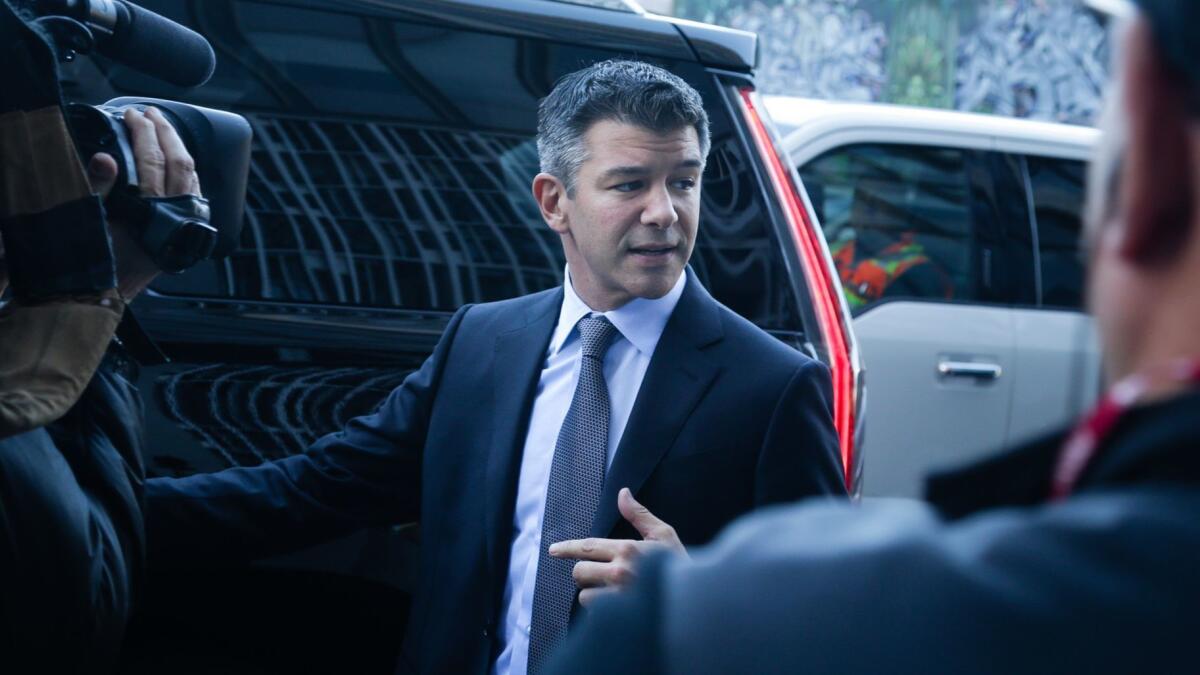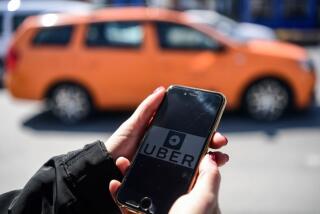Column: Uber’s IPO filing shows it’s looking for the greater fools

The long-anticipated initial public offering filing Thursday by uber-unicorn Uber, the big ride-sharing company, evokes two principles.
One is Wall Street’s “greater fool” principle, which holds that any investment’s value can be justified if one thinks that a greater fool can be gulled into buying it at that price or higher. The other derives more from gaming: It says that if you look around the table and can’t spot the sucker, it’s you.
That’s not investment advice about the Uber IPO. Greater fools always are thick on the ground in the investment world, and sometimes even suckers can walk away in the black. But the Uber disclosure statement does suggest that the excitement about this stock offering has almost nothing to do with its business prospects.
Uber’s approaching IPO aims to raise $10 billion, which would value the company at $90 billion to $100 billion. That’s an eye-catching valuation but a bit of a decline from the last figure being tossed around, $120 billion. The reduction seems to be based partially on the experience of Lyft, the second-biggest ride-hailing company.
We may not achieve profitability.
— Uber IPO prospectus
Lyft staged its IPO on March 29 at a valuation of $24 billion and soared as high as $88.60 per share on its first day of Nasdaq trading. In midday trading Friday, Lyft shares were priced at about $58.50, a decline of about 34% from those prehistoric days two weeks ago. (Of course, some of that decline could be ascribed to news of Uber’s upcoming IPO, which could lure investors from Lyft.)
Of course, although Lyft and Uber are ostensibly in the same business of brokering auto rides by bringing together passengers and drivers via smartphone apps, they have divergent pros and cons. Lyft is much smaller, supposedly a drawback in a winner-takes-all marketplace. But it’s not saddled by Uber’s noisome corporate reputation, a product of the bro-noxious culture fostered by its co-founder Travis Kalanick, who was ousted as CEO in 2017 but still owns 8.6% of Uber’s stock and has a seat on the board.
(His successor, Dara Khosrowshahi, acknowledges in a letter appended to the IPO filing that “that famous Uber hustle … led to missteps along the way.” And the company lists its workplace culture among its “risk factors.”)
Uber’s IPO has been hungrily anticipated because of its stature as the biggest unicorn — companies valued at more than $1 billion — in the technology market. So its fate will be a bellwether for how these companies, which have been sucking up venture investors’ cash at a rapid rate, will fare once they’re subjected to the scrutiny of the public market. The offering is also a test of investors’ appetite for companies whose record of stupendous losses would rate horselaughs under traditional investment principles.
Bloomberg’s Matt Levine amusingly (but rather tactlessly) has traced the trajectory of Uber’s putative valuation since 2013. It started with a $3.5-billion valuation that year, followed by a $1.2-billion capital raise from venture investors in June 2014 at a valuation of $17 billion, then another investment round in May 2015 at a $50-billion valuation, then $72 billion, and now $90 billion to $100 billion.
These are big numbers, but as Levine observed, the rate of increase has slowed as reality begins the painstaking process of interceding itself in the world of dreams.
It’s possible that Uber recognizes that its operational record doesn’t warrant its lofty valuation — or recognizes that public investors may be getting wary of highly touted companies that have never turned a profit. Uber’s IPO registration discloses that the company has lost $10.1 billion from operations in the last three years. In 2018, Uber lost $3 billion on revenue of $11.27 billion; the year before, it lost $4.1 billion on revenue of $7.9 billion.
Uber’s revenue continues to grow, but at a declining rate — higher by 105% in 2017 compared with 2016, but by only 42% in 2018 compared with 2017. Its losses are shrinking as a share of revenue — to 26.9% last year, from about 52% the year before. But that doesn’t necessarily mean it’s on a glide path to profitability. “We may not achieve profitability,” the company discloses.
Let’s look at some other metrics.
Uber long has portrayed its potential market as virtually the entire universe of transportation, and repeats that notion in its prospectus, calculating its “total addressable market” at “all passenger vehicle miles and all public transportation miles in all countries globally,” or “11.9 trillion miles per year, representing an estimated $5.7 trillion market opportunity in 175 countries.”
That statement can best be viewed as aspirational, because its ability to capture even a significant share of those miles is implausible. One hint of how implausible is what’s happened to Uber’s business in recent quarters — it’s been flat-lining or even declining.
The company’s “core adjusted net revenue,” which it says is a key metric derived from fares minus driver incentives and other miscellaneous charges, fell to $2.54 billion in the fourth quarter of last year, from a peak of $2.56 billion in the third quarter. Its adjusted net revenue from its promising Uber Eats program, which delivers meals from local restaurants to stay-at-home diners, fell to $165 million in the fourth quarter, from a peak of $218 million in the second quarter.
Meanwhile, the company’s “adjusted EBITDA” losses increased sharply at the end of last year, to $817 million, from $280 million in the first quarter.
What’s happening is competition. The company says it will use incentives, “such as promotions for Drivers and consumers, to attract platform users on both sides of our network.” That means giving drivers a larger share of fares and cutting prices for passengers. The result, the prospectus says, will be “a negative margin until we reach sufficient scale to reduce incentives.” In other words, Uber will lose money until it has pricing power over the marketplace, if that ever happens.
Another worrisome aspect of Uber’s business is that it’s highly concentrated. About 24% of its ride bookings come from only five metropolitan areas — Los Angeles, New York, San Francisco, London and Sao Paolo, Brazil. Some of those communities already have placed or are considering surcharges on Uber rides or imposing minimum-wage standards. New York has capped the number of ride-hailing permits. Uber desperately needs to expand into new regions, but that’s where its reputation for bullishness and boorishness precedes it.
Like Lyft, Uber paints a picture of a distant future in which it turns a profit but gives no hint of how it will get there, except that eventually it will become such a bigfoot in transportation that it can charge what the market will bear. Along the way, however, its head winds include rivals just as determined as it is, as well as the prospect that government agencies and the courts will order it to reclassify its drivers as employees rather than independent contractors.
That would mean Uber assuming expenses it now fobs off on the drivers, such as gasoline, insurance and wear and tear on their vehicles, while also paying overtime, Social Security and other benefits. That would “require us to fundamentally change our business model,” Uber says, though it offers no clues about what the new model would look like. That may be the clearest sign that IPO investors will be buying the proverbial pig in a poke.
For all its claims to bring something unique to the transportation sector, Uber doesn’t really have the ability to build a wall against competitors. Its IPO may be more a test of investment market sentiment than sentience about its actual business. That doesn’t mean its shares won’t rise and generate gains for investors, just that it wouldn’t hurt plungers to look around the table, keeping an eye out for the greater fool and trying to find the sucker.
Keep up to date with Michael Hiltzik. Follow @hiltzikm on Twitter, see his Facebook page, or email [email protected].
Return to Michael Hiltzik’s blog.







